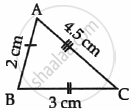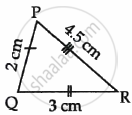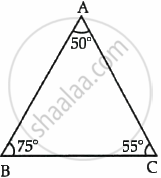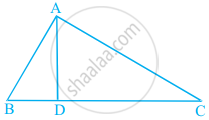Advertisements
Advertisements
Question
Observe the figures given below carefully and answer the questions:
| Figure A |  |
 |
| Figure B |  |
 |
| Figure C |  |
 |
- Name the figure(s) where in two figures are similar.
- Name the figure(s) where in the figures are congruent.
-
- Prove that congruent triangles are also similar but not the converse.
OR - What more is least needed for two similar triangles to be congruent?
- Prove that congruent triangles are also similar but not the converse.
Solution
- Figures A and C are similar.
- Only Figure C is congruent.
-
- All congruent figures are similar but all similar figures are not congruent.
For example, a pair of triangles that are similar by the A.A.A. test of similarity are not congruent pairs of triangles since the exact lengths of the sides are unknown.
In ΔABC and ΔDEF,
∠A = ∠D = 50°,
∠B = ∠E = 75°
and ∠C = ∠F = 55°.
Hence, ΔABC ∼ ΔDEF but they are not congruent.
OR

- The length of corresponding sides must be equal.
- All congruent figures are similar but all similar figures are not congruent.
APPEARS IN
RELATED QUESTIONS
All squares are ______.
Write the truth value (T/F) of each of the following statement
Two triangles are similar if their corresponding angles are proportional.
For each of the following statements state whether true(T) or false (F)
if two triangles are similar then their corresponding angles are equal and their corresponding sides are equal
For each of the following statements state whether true(T) or false (F)
The length of the line segment joining the midpoints of any two sides of a triangles is equal to half the length of the third side.
For each of the following statements state whether true(T) or false (F)
In a ΔABC , AB = 6 cm, ∠A = 45° and AC = 8 cm and in a ΔDEF , DF = 9 cm ∠D = 45° and DE= 12 cm then ΔABC ∼ΔDEF
The symbol ~ is used to represent _________ triangles
ΔABC is an equilateral A of side a. Its area will be ______.
In a rhombus if d1 = 16 cm, d2 = 12 cm, then the length of the side of the rhombus is ______.
Given below is the picture of the Olympic rings made by taking five congruent circles of radius 1cm each, intersecting in such a way that the chord formed by joining the point of intersection of two circles is also of length 1cm. Total area of all the dotted regions assuming the thickness of the rings to be negligible is ______.

In Figure, ∠BAC = 90° and AD ⊥ BC. Then, ______.
